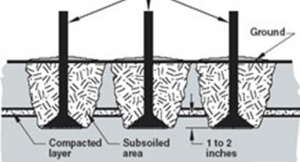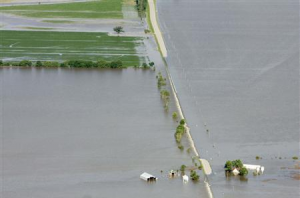Managing water on farms is hugely complex. It is important to collect water for dry times, since without water, very little will grow. At the same time, too much water can very, very quickly destroy entire crops, and perhaps most dangerously, carry away a farmer’s most valuable resource: the soil. This is especially problematic for those growing annual plats like corn, wheat, soy, or most vegetables. Since these crops grow only for a single season, they have very shallow rooting systems. Throughout the spring melt season, when floods are common, these crops are nonexistent or very, very small, offering little in the way of soil anchoring or water buffering power. Furthermore, many ‘conventional’ farmers leave their fields bare when not growing any crop, leaving them at risk of erosion by both wind and water. This erosion usually happens in two ways; river intrusion and gullying. River intrusion is just what it sounds like; rivers breaking their banks and inundating or washing away farmland.
The roots of this problem are simple. Rivers have always flooded, and will always flood. Problems arise when people build and farm in ways that ignore this fact. For instance, channelizing a river and confining it to a very strait path will prevent small floods, but in large events when the river does overtop the dykes and banks, huge areas of land are suddenly flooded, as happened throughout the Missouri and Mississippi river floodplains in the spring of 2011. Channel restoration is a field unto itself, so it will suffice to say that the more a river is allowed to meander as it ‘pleases’, the less intense its flow, the less erosive power it possesses, and the less catastrophically it will flood. So how might an individual farmer, with no real control over watershed-scale river engineering, reduce damage to their own property? The simplest is the establishment of vegetative buffers along existing streams or rivers. Planting trees, shrubs, and even hardy grasses has a multitude of benefits. First of all, perennial roots anchor soil and prevent erosion throughout the year. Additionally, the profusion of stems along a riverbank can help slow water down and disperse its force. They can also protect a farm from flood-borne debris that could damage buildings or equipment. And these buffers need not be a ‘waste’ of otherwise productive land; if the right species are planted, buffers provide wildlife habitat, and can produce valuable berries, fruit, and even lumber or other wood products. Another important function of dense vegetative buffers is that they can exclude livestock that have the potential to damage banks.
 Stream bank badly damaged by cattle
Stream bank badly damaged by cattle
Keith Morris is a teacher at UVM and also owns a small farm outside Johnson VT. The farm sits on a bend in the Lamoille River. Keith has been aggressively restoring the riverbank for years, and his buffer contains several species of raspberries and gooseberries, as well as black walnuts which will eventually produce high-quality saw timber or veneer. He reports that in the large floods in spring of 2012, nearly the entire farm was under at least a foot of water. However, the dense thicket at the water’s edge captured three large logs that would otherwise likely have struck and damaged the buildings onsite. His vegetation also slowed water to the extent that his bank grew from deposition rather than being eroded away.
 Keith Morris’ Farm in Johnson. A Vegetative buffer protects the buildings and farm from the full force of the river.
Keith Morris’ Farm in Johnson. A Vegetative buffer protects the buildings and farm from the full force of the river.
Of even more concern for many farmers is gullying and erosion from the farm. Water will always flow downhill, and if it picks up very much speed at all, it will begin to carry soil particles as well. Despite the characterization as such, not even Iowa and Kansas are truly flat, so this problem is potentially universal. One simple technique is referred to as contour tillage. Plowing and planting takes place on curves that follow a constant elevation around hills, much like following a contour line on a map. This way, furrows run perpendicular to the hillside, keeping small amounts of water from being able to flow downhill. Coupled with cover crops to maintain soil coverage year-round, this technique is fairly successful. However, if it rains enough to overtop furrows, gullying and erosion can still be an issue.
However, more complex systems have evolved to address larger flows while also stockpiling water for drier times of the year. Keyline design was invented by P.A. Yeomans, and Australian engineer-turned-farmer, drawing upon older water management techniques and styles. The idea is this: after establishing a Key line, which follows the break over from steeper to less-steep slopes, ditches or swales are built at regular intervals parallel to the key line up and down the slope. These lines approximate contour lines, but with a key difference: any given lie is higher where it crosses a valley than where it crosses a ridge. This means that water flows from the valley to the ridge, though along very shallow, slow ditches. The result is that rather than concentrating in valleys and flowing strait down, water is spread over the whole of a hillside and re-distributed to usually-dry ridges. This distribution and slowing of water allows more of it to sink into the soil, which means both that it is no longer an erosive force, but is also stored beyond the timeframe of an individual precipitation event.
The Keyline Concept
Plowing also takes place parallel to these key lines, mimicking the larger ditches across every inch of the landscape. The final detail that Yeomans advocates for is the use of a special, very deep ploughing method. The use of a Keyline Plow, also known as a subsoiler, aerates soil without destroying its microbial life, enhancing soil’s natural capacity for absorption.
Operation of a Subsoiler
Erosion can be a huge problem, resulting in soil loss, sedimant runoff, and other problems. Farmers have created many exciting techniques for reducing the damaging power of water on their lands and more effectively use it to their benefit.
-Brian
Resources:
The Keyline Plan by PA Yeomans:
http://www.soilandhealth.org/01aglibrary/010125yeomans/010125toc.html
Willow Crossing Farm:
http://prospectrockpermaculture.wordpress.com/about/
USDA Environmental Quality Incentives Program
http://www.nrcs.usda.gov/wps/portal/nrcs/main/in/programs/financial/eqip/
Other Image Sources:
http://ecan.govt.nz/advice/your-business/farming/Pages/protecting-soil-from-stock-damage.aspx
http://www.fs.fed.us/t-d/pubs/htmlpubs/htm08342828/page03.htm
http://www.rolybrown.ca/gallery2/main.php?g2_itemId=1238
http://www.reuters.com/article/2011/06/25/us-flooding-iowa-idUSTRE75O1WB20110625
